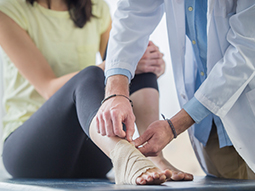
With its roots in Native American cultures, lacrosse is America’s oldest and currently fastest-growing team sport. Played by girls and boys of all ages, it is a fast-paced, free-flowing game. Its combination of speed, quick change of direction, stick, ball, and contact make for a unique set of injuries.
Girls’ and boys’ lacrosse
Though sharing general concepts of play, girls’ and boys’ lacrosse are somewhat different with regard to allowed contact, required protective equipment and resulting injuries. For girls, intentional body-to-body contact is not legal and stick checking must be directed away from an opponent’s head and body, toward the pocketed end of the stick only. Protective goggles and mouth pieces are mandatory with lightweight gloves and soft headgear optional. Boys’ lacrosse is a higher contact sport which requires the mandatory use of helmets with full face guards, shoulder pads, padded gloves, and mouthpieces, and suggested use of elbow pads and protective genital cups.
Injuries
Overall, lacrosse is a moderate-risk sport in which the vast majority of injuries are minor strains, sprains, and bruises. However, more significant injuries, including the following, can occur.
-
Non-contact ankle and knee ligament sprains, sustained while cutting and dodging, are common in both girls’ and boys’ lacrosse. At the scholastic level, ankle sprains represent 21 percent of all reported injuries for girls and 16 percent for boys.
-
Knee injuries, including ACL tears, are the leading cause of lost game and practice time for both girls and boys.
-
Muscle strains of the hamstrings, quadriceps, and groin are common and related to similar, non-contact injuries.
-
Head and face injuries, including concussions, are less frequent but still an important issue for the game. Most commonly related to body-to-body or body-to-ground contact in the boys; game and inadvertent stick or ball contact in the girls; games, these injuries are more frequent in game than practice situations.
-
Shin splints and foot blisters are common and related to continuous running and changing field surfaces.
-
Scrapes on the uncovered lower extremities are common and require appropriate cleaning and protection.
-
Seen more commonly in baseball and hockey, commotio cordis is very rare cardiac arrhythmia related to ball to chest contact. The few cases in lacrosse have involved adolescent boys. The condition is best treated by early activation of the EMS system and utilization of on field AEDs.
How are lacrosse injuries treated?
With any injury, participation should be stopped until an assessment is made by a qualified health professional. For minor injuries, treatment usually includes rest, ice, and elevation. Other injuries may be more serious and require a longer period of rest and rehabilitation. These athletes may be allowed to participate with modifications, depending on the risk for reinjury. In the most severe cases, surgery may be required. All head injuries should be thoroughly evaluated. Athletes should return to play on a graduated schedule and only when completely symptom free.
How are lacrosse injuries prevented?
-
Respect the game. Although boys’ lacrosse allows significant contact, it is still a game that requires finesse and skill. Unprotected hits have no place in the game. For girls, rules which promote a free style of play and limit intentional body-to-body contact must be adhered to by coaches, officials, and players. Maintain open communication. Discuss your lacrosse goals and health concerns with your sponsoring lacrosse organization, coach, trainer, parents, and health provider to ensure the right steps are made to enjoy the game and to prevent and treat injuries.
-
Be proactive in your conditioning. Stay in shape year-round. Prior to the lacrosse season, start a graduated program of plyometrics, neuromuscular training, conditioning, and strength training geared to lacrosse demands. Warm up properly by thoroughly stretching and gradually increasing the intensity of your workouts. Hydrate regularly and get plenty of rest.
-
Wear the right equipment. Protective equipment should be appropriately sized. Do not modify mouth pieces or gloves for comfort.
-
Take a break. All lacrosse players should have at least one or two days a week and one or two months a year away from lacrosse to stay fresh and prevent burnout.
-
Report all injuries. Decrease training time and intensity if pain or discomfort develops.
-
Have a plan. All lacrosse organizations should have a well-established emergency medical plan and injury prevention/education programs for their membership. Contact US Lacrosse at www.uslacrosse.org. for more information
Q&A with our USA Lacrosse head athletic trainer

Learn more about our athletic trainer, Kellie Loehr, and the role she and the MedStar Health team play at USA Lacrosse.
Our providers

Expert orthopedic care
Getting the care you need starts with seeing one of our sports medicine specialists.









